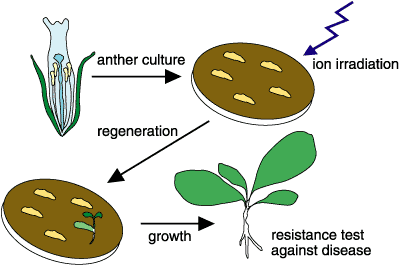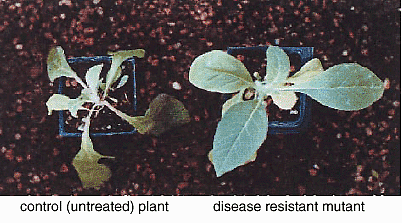Potato virus Y (PVY), which causes yellow spotted streak in many solanaceous crops, is distributed worldwide, resulting in economic losses. In tobacco, several varieties with resistance against PVY, such as Virginia-A mutant, have been developed. At present, however, this has little practical merit, because of the emergence of undesirable characters such as a decrease of the exudates on the leaves.
Ion beams have several characteristics: energy is deposited more extensively on the material compared to gamma-rays and X-rays, and the penetration range can be controlled in the target material. Accordingly, a lot of energy can be deposited on the material at the point exposed to the focussed ion beams. It has been experimentally determined using the TIARA facility that He, C and Ne ion beams have higher biological effects than gamma-rays and/or electrons.
From a biological viewpoint, haploid plants are useful in detecting recessive mutations, and can be genetically fixed by chromosome duplication. Anther culture has been established as a method to obtain useful mutants. Experiments to obtain plants highly resistant to PVY have been performed by combining ion beam irradiation with anther culture (Fig. 5-10).
PVY resistance was tested by inoculating a suspension of PVY to the 7th or 8th leaves. Among the 472 plants derived from the irradiated anthers, 15 plants were resistant to PVY. Mutation frequency was very high as shown in Table 5-1. Moreover, in these resistant plants, undesirable characters such as low yield and decrease of leaf surface exudates were not found. These plants must be useful breeding sources to produce PVY resistant tobacco cultivar. |


